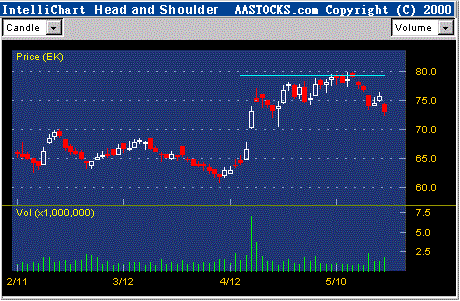|
Technical Trading Strategies
Technical analysts and traders believe that certain
stock chart patterns and shapes are signals for profitable trading opportunities. Many
professional and amateur traders claim that they consistently make trading profits by
following those signals. In this chapter we introduce eight types of stock patterns and
the corresponding trading strategies, that, according to our extensive historical tests,
give the trader an advantage.
"Head-and-Shoulders"
The "Head-and-Shoulders" pattern is believed to be one of the most reliable trend-reversal patterns.
The figure below shows an example of a short-term Head-and-Shoulders pattern:

Figure 15. This is the famous "Head-and-Shoulders" formation, a sell
signal.
The strategy indicated by the "Head-and-Shoulders" pattern is to
short-sell
the stock as the price drops down the second shoulder, especially if the volume also goes up.
Then one can hold the position until the price drops all the way down to the level of
significant supports and consolidation. This signal also indicates that one should cut
loss if the price rises above the tip of the head. A less-risky stop- loss strategy is
to cut losses if the price goes back up the top of the second shoulder.
|
